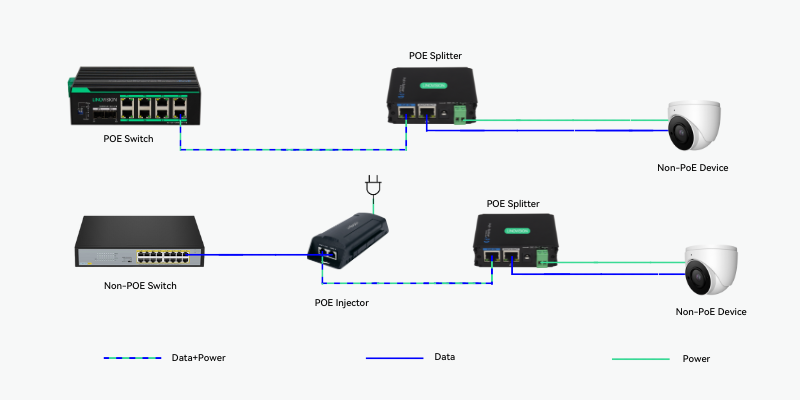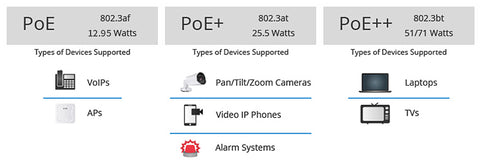Unlocking the Secrets of PoE Switches — A Complete Guide
Power over Ethernet (PoE) switches have gained significant popularity as a practical solution for businesses seeking to conveniently deliver power and data through a single connection. In this comprehensive guide, we will delve into the various types of PoE switches, highlight their advantages and applications, and provide insights on selecting the most suitable PoE switch to meet your specific requirements.
What is a PoE Switch?
A PoE switch combines the functionalities of a switch and a power source into a single device. Equipped with multiple Ethernet ports, these switches facilitate seamless connections with various devices such as VoIP phones, wireless access points, and IP cameras. By integrating power delivery capabilities, PoE switches eliminate the need for separate power cables, streamlining installations. These switches prove particularly beneficial in network deployments where power outlets are limited or in scenarios where devices are situated in challenging-to-access locations.
PoE switches leverage the power over Ethernet (PoE) technology, enabling the simultaneous transmission of data and electrical power through Ethernet cables. This innovative technology employs a combination of power sources and power injectors to deliver power to connected devices. Acting as intermediaries between the power source and the devices, power injectors handle the transmission of both data and power, ensuring efficient operation. Also Check- PoE switch

Types of PoE Switches
When selecting a PoE switch, it is vital to familiarize yourself with the various types available. There exist two primary categories of PoE network switches:
The Unmanaged PoE Switch
Designed for simplicity and ease of use, the unmanaged PoE switch offers a plug-and-play solution that suits smaller setups. It requires minimal configuration and is user-friendly. However, it lacks extensive customization options, management features, and advanced security capabilities. Consequently, it is best suited for applications with uncomplicated network requirements, such as home networks or small-scale environments comprising fewer than 5-10 computers.
The Managed PoE Switch
Engineered to deliver enhanced control and comprehensive network management, managed PoE switches excel in scenarios that demand advanced functionality. With their robust security features and extensive configuration options, they prove ideal for applications like enterprise networks, data centers, and large-scale surveillance systems. These switches offer features such as VLANs (Virtual Local Area Networks), QoS (Quality of Service), port mirroring, and heightened port security, catering to complex networking requirements.
Advantages of PoE Switches
Given how PoE switches work, the benefits of PoE switches are obvious.
Simplified Installation: PoE network switches are known for their user-friendly installation and configuration. With plug-and-play functionality, these switches eliminate the need for complex wiring or intricate setup procedures. Built-in features like port mirroring, VLANs, and QoS further simplify network management tasks, enhancing overall operational convenience.
Cost Efficiency: PoE switches exhibit remarkable energy efficiency. By intelligently delivering the precise power required for each connected device, they eliminate the need for oversized power supplies. This efficient power allocation not only reduces energy consumption but also contributes to long-term cost savings, making PoE switches a financially advantageous choice.
Enhanced Flexibility: The ability to power devices through PoE enables easy relocation to areas without available power outlets. This flexibility allows PoE switches to be conveniently placed in challenging-to-reach locations or areas distant from power sources. Security cameras, for instance, can be strategically installed in optimal positions, regardless of the availability of nearby power outlets.
Future-Proofing: With the rapid growth of the Internet of Things (IoT) industry, PoE switches provide future-ready infrastructure. By incorporating PoE switches into your network, you can seamlessly accommodate the increasing number of devices designed to leverage this technology. This scalability ensures long-term compatibility and positions your network for seamless integration with emerging IoT devices.
PoE Switch Applications
This rapid expansion of network-connected devices means that PoE technology and PoE switches will grow in importance to most networking infrastructures. While PoE switches have numerous applications, we mainly discuss the three most common application scenarios.
-
VoIP Phones: VoIP phones are PoE devices, with PoE allowing for a single connection to the wall socket and the ability for remote powering down
-
IP Cameras: Security cameras can be connected to PoE switches to enable fast deployment and simple repositioning.
-
Wireless: Many wireless access points are PoE compatible. Thus, PoE switches allow for easy relocation and remote positioning.
-
Smart Home Automation: LED lighting, heating and cooling systems, appliances, voice assistants, and electric car charging stations.
How to Select the Right PoE Switch
When selecting a PoE switch, it is important to consider your application requirements, the features and limitations of the PoE network switch. Of course, the power requirements of connected devices are also important. Some PoE network switches are designed to power devices that require up to 30 watts, and some are even designed for power devices that require up to 60 watts.
Features of PoE Switches to Consider
In addition to the type of switch and power requirements, there are a number of features to consider when selecting a PoE switch. These features include port speed, port count, port types, PoE budget, power savings, and port security.
-
Port speed: Maximum speed a port can achieve. It is important to choose a switch with a port speed that can support the connected devices. The port count is the number of ports available on the switch. It is important to choose a switch with enough ports to accommodate all of the connected devices.
-
Port type: Common port types include RJ45, SFP, and SFP+. It is important to choose a switch with the right port type for connected devices.
-
PoE budget: Maximum amount of power that can be allocated to connected devices. It is important to choose a switch with a PoE budget that can accommodate all of the connected devices.
-
Power savings: Designed to conserve energy by automatically turning off unused ports. This can help to reduce energy costs.
-
Port security: Designed to protect connected devices from unauthorized access.
Limitations of PoE Switches
Nonetheless, there are some limitations to PoE variation that you should be aware of:
-
Restrictions on distance: Typically, PoE switches can transmit over Ethernet up to a distance of up to 100 meters. The 100-meter distance restriction presents a challenge for large campuses, restaurants, and businesses implementing PoE. However, there are still devices like power extenders and powered fiber cables that can be used to extend the PoE range.
-
Power: If you require high power over poe networks, you must ensure that the power capacity of your PoE switches meets your requirements due to the power limitation imposed by PoE standards and Wattage.
FAQs about PoE Switch
Q: Non-PoE vs. PoE Switch: How do they differ?
A: Non-PoE switches cannot deliver power to connected devices, necessitating the use of midspan power sourcing equipment (PSE), such as a PoE injector. This setup adds power while transmitting data to powered devices (PDs). In contrast, PoE switches offer a simpler solution, directly delivering power and data to PDs with just a network cable and a power cable.

Also Check- PoE vs PoE+ vs PoE++ Switch: How to Choose?
Q: Do PoE Switches Require Special Cables?
A: No. The Ethernet cables that should be used for PoE network switches primarily depend on the data rate of the PoE port; for instance, Cat3 or better cables can be used for 10/100M; Cat5/Cat5e/Cat6 cables are required for 1000M. In the future, Cat6a or higher cables may be required for the installation of 2.5G/5G/10G PoE devices.
Q: Active vs Passive PoE Switch: Should I Choose Active or Passive PoE Switches?
A: Active PoE network switch complies with standard PoE. On the contrary, passive PoE network switch does not adhere to any IEEE standard. There are many ways that active and passive PoE switches differ from one another, like how the PoE power supply pinout looks and whether or not they support Ethernet.
Also Check- Active vs. Passive PoE Switch: Which Should We Choose?
Q: Can the PoE Switch be used with a computer or other non-PoE devices? And will a PoE switch harm devices that do not use PoE?
A: Yes, a PoE switch can be used with non-PoE devices like computers. The switch automatically detects whether a connected device is PoE-compatible and will only supply power to PoE-enabled devices. So, it won't harm non-PoE devices; they just won't receive power through the switch.
Q: Is it possible to connect two PoE switches?
A: You could, yes. The PSE only supplies PD with power when it determines that the device can handle it. As PSEs, the two PoE switches will only be used for data communications.
Q: What is the maximum transmission distance of PoE? How to extend the transmission distance of PoE?
A: Whether using IEEE 802.3af (PoE) or 802.3at (PoE+), data and power transmission are limited to a distance of 100 meters over Ethernet cables in standard PoE. Media converters and PoE extenders, for example, can extend the range to up to 300 meters if you want to increase the maximum distance.
Conclusion
PoE switches are an effective solution for businesses looking to provide power and data over a single connection. They can simplify installation, reduce clutter, and improve energy efficiency. When selecting a PoE network switch, it is important to consider your application requirements, the power requirements of the connected devices, and the features of the switch. It is also important to consider the cost and long-term cost savings of using a PoE network switch.
If you are looking for a reliable and cost-effective PoE switch, check out Linovision PoE Switches.






































